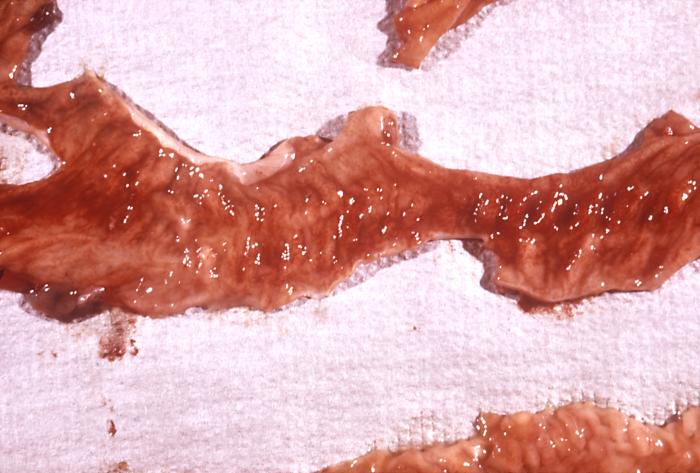[1]
Nesher L, Rolston KV. Neutropenic enterocolitis, a growing concern in the era of widespread use of aggressive chemotherapy. Clinical infectious diseases : an official publication of the Infectious Diseases Society of America. 2013 Mar:56(5):711-7. doi: 10.1093/cid/cis998. Epub 2012 Nov 29
[PubMed PMID: 23196957]
[2]
Kaito S, Sekiya N, Najima Y, Sano N, Horiguchi S, Kakihana K, Hishima T, Ohashi K. Fatal Neutropenic Enterocolitis Caused by Stenotrophomonas maltophilia: A Rare and Underrecognized Entity. Internal medicine (Tokyo, Japan). 2018 Dec 15:57(24):3667-3671. doi: 10.2169/internalmedicine.1227-18. Epub 2018 Aug 10
[PubMed PMID: 30101922]
[3]
Gorschlüter M, Mey U, Strehl J, Ziske C, Schepke M, Schmidt-Wolf IG, Sauerbruch T, Glasmacher A. Neutropenic enterocolitis in adults: systematic analysis of evidence quality. European journal of haematology. 2005 Jul:75(1):1-13
[PubMed PMID: 15946304]
Level 2 (mid-level) evidence
[4]
Aksoy DY, Tanriover MD, Uzun O, Zarakolu P, Ercis S, Ergüven S, Oto A, Kerimoglu U, Hayran M, Abbasoglu O. Diarrhea in neutropenic patients: a prospective cohort study with emphasis on neutropenic enterocolitis. Annals of oncology : official journal of the European Society for Medical Oncology. 2007 Jan:18(1):183-189. doi: 10.1093/annonc/mdl337. Epub 2006 Oct 5
[PubMed PMID: 17023562]
[5]
Moran H, Yaniv I, Ashkenazi S, Schwartz M, Fisher S, Levy I. Risk factors for typhlitis in pediatric patients with cancer. Journal of pediatric hematology/oncology. 2009 Sep:31(9):630-4. doi: 10.1097/MPH.0b013e3181b1ee28. Epub
[PubMed PMID: 19644402]
[6]
Urbach DR, Rotstein OD. Typhlitis. Canadian journal of surgery. Journal canadien de chirurgie. 1999 Dec:42(6):415-9
[PubMed PMID: 10593241]
[7]
Katz JA, Wagner ML, Gresik MV, Mahoney DH Jr, Fernbach DJ. Typhlitis. An 18-year experience and postmortem review. Cancer. 1990 Feb 15:65(4):1041-7
[PubMed PMID: 2404562]
[8]
Kirkpatrick ID, Greenberg HM. Gastrointestinal complications in the neutropenic patient: characterization and differentiation with abdominal CT. Radiology. 2003 Mar:226(3):668-74
[PubMed PMID: 12601214]
[9]
Tamburrini S, Setola FR, Belfiore MP, Saturnino PP, Della Casa MG, Sarti G, Abete R, Marano I. Ultrasound diagnosis of typhlitis. Journal of ultrasound. 2019 Mar:22(1):103-106. doi: 10.1007/s40477-018-0333-2. Epub 2018 Oct 27
[PubMed PMID: 30367357]
[10]
Pugliese N, Salvatore P, Iula DV, Catania MR, Chiurazzi F, Della Pepa R, Cerchione C, Raimondo M, Giordano C, Simeone L, Caruso S, Pane F, Picardi M. Ultrasonography-driven combination antibiotic therapy with tigecycline significantly increases survival among patients with neutropenic enterocolitis following cytarabine-containing chemotherapy for the remission induction of acute myeloid leukemia. Cancer medicine. 2017 Jul:6(7):1500-1511. doi: 10.1002/cam4.1063. Epub 2017 May 26
[PubMed PMID: 28556623]
[11]
Freifeld AG, Bow EJ, Sepkowitz KA, Boeckh MJ, Ito JI, Mullen CA, Raad II, Rolston KV, Young JA, Wingard JR, Infectious Diseases Society of America. Clinical practice guideline for the use of antimicrobial agents in neutropenic patients with cancer: 2010 update by the infectious diseases society of america. Clinical infectious diseases : an official publication of the Infectious Diseases Society of America. 2011 Feb 15:52(4):e56-93. doi: 10.1093/cid/cir073. Epub
[PubMed PMID: 21258094]
Level 1 (high-level) evidence
[12]
Salazar R, Solá C, Maroto P, Tabernero JM, Brunet J, Verger G, Valentí V, Cancelas JA, Ojeda B, Mendoza L, Rodríguez M, Montesinos J, López-López JJ. Infectious complications in 126 patients treated with high-dose chemotherapy and autologous peripheral blood stem cell transplantation. Bone marrow transplantation. 1999 Jan:23(1):27-33
[PubMed PMID: 10037047]
[13]
Smith TJ, Khatcheressian J, Lyman GH, Ozer H, Armitage JO, Balducci L, Bennett CL, Cantor SB, Crawford J, Cross SJ, Demetri G, Desch CE, Pizzo PA, Schiffer CA, Schwartzberg L, Somerfield MR, Somlo G, Wade JC, Wade JL, Winn RJ, Wozniak AJ, Wolff AC. 2006 update of recommendations for the use of white blood cell growth factors: an evidence-based clinical practice guideline. Journal of clinical oncology : official journal of the American Society of Clinical Oncology. 2006 Jul 1:24(19):3187-205
[PubMed PMID: 16682719]
Level 1 (high-level) evidence
[14]
Shamberger RC, Weinstein HJ, Delorey MJ, Levey RH. The medical and surgical management of typhlitis in children with acute nonlymphocytic (myelogenous) leukemia. Cancer. 1986 Feb 1:57(3):603-9
[PubMed PMID: 3484659]
[15]
Saillard C, Zafrani L, Darmon M, Bisbal M, Chow-Chine L, Sannini A, Brun JP, Ewald J, Turrini O, Faucher M, Azoulay E, Mokart D. The prognostic impact of abdominal surgery in cancer patients with neutropenic enterocolitis: a systematic review and meta-analysis, on behalf the Groupe de Recherche en Réanimation Respiratoire du patient d'Onco-Hématologie (GRRR-OH). Annals of intensive care. 2018 Apr 19:8(1):47. doi: 10.1186/s13613-018-0394-6. Epub 2018 Apr 19
[PubMed PMID: 29675758]
Level 1 (high-level) evidence
[16]
Wade DS, Nava HR, Douglass HO Jr. Neutropenic enterocolitis. Clinical diagnosis and treatment. Cancer. 1992 Jan 1:69(1):17-23
[PubMed PMID: 1727660]
